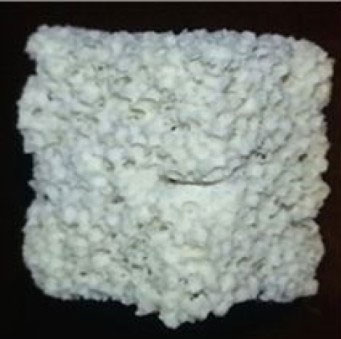Beer waste can help regenerate bone
(Researchers) - Researchers from UPM and CSIC have developed biological materials from waste in the brewing process to regenerate bone.
According to research results from the Center for Biomaterials Technology University of Politécnica de Madrid (UPM), Research Institute of Materials, Catalysts and Petroleum Chemistry of Spain's major research center Consejo Superior de Investigaciones Científicas (CSIC), in partnership with Mahou and Createch, developed materials with biological compatibility. This material is used as a bone regeneration aid from food industry waste, mostly from pulp (the remainder) after brewing. This new material can be considered as a replacement for prosthetics made from sheep bone or expensive synthetic materials, which are harmful to the environment.

Biomaterials are used as molds in bone regeneration and are generated from treated beer residues
Waste from the brewing process contains the main chemical components found in bones such as phosphorus, calcium, magnesium and silica. After undergoing the transformation process, this waste can be used as a support tool or a frame to promote bone regeneration in medical applications by rinsing a layer of prosthetic bone or bone graft. The use of waste from the food industry is a way of restoring abundant raw materials, enriching chemical diversity, and it also reduces the effects caused by the accumulation of waste in the environment.
So far, the use of artificial materials such as a replacement for real bones is the most common therapy used to treat bone diseases. The method of treatment based on the pattern is a hard, hollow shaped frame made of biocompatible materials. This pattern will provide mechanical stability and promote the growth of new bone tissue, helping to regenerate it.
Artificial calcium phosphate is often used as an external template and coating in orthopedic implants because of its similarity to bone components. The residue of beer is composed of the organic waste of malt, never undergoing the transformation process afterwards. This is why beer residue is considered a by-product, often used for animal feed and it is not expensive. Analysis of the composition of this material shows that the existence of interconnected pores in a diameter of 50 to 100 micrometers is similar to the porosity of porous bone. All of this will facilitate complete circuit distribution after bone transplantation.
- Waste, animal fat in chewing gum, tattoo ink
- The unexplored truth about beer
- Beer and 24 mysteries that you can't expect
- America successfully recreates bones from stem cells
- Drinking beer makes bones stronger and less broken
- Biological glues help to regenerate bone naturally
- 9 interesting things about beer
- Producing electricity from beer residues
- There is going to be brewed dry beer like coffee
- Learn the history of beer
- Can beer be seduced by drinkers?
- What makes the world's top beer?
 Green tea cleans teeth better than mouthwash?
Green tea cleans teeth better than mouthwash? Death kiss: This is why you should not let anyone kiss your baby's lips
Death kiss: This is why you should not let anyone kiss your baby's lips What is salmonellosis?
What is salmonellosis? Caution should be exercised when using aloe vera through eating and drinking
Caution should be exercised when using aloe vera through eating and drinking How does smoking change the structure of human bones?
How does smoking change the structure of human bones?  Shocked by another human species' 130,000-year-old artwork
Shocked by another human species' 130,000-year-old artwork  High-frequency sound waves turn stem cells into bone cells in just 5 days
High-frequency sound waves turn stem cells into bone cells in just 5 days  Experimental study using vaccine technology to heal bones
Experimental study using vaccine technology to heal bones  Tiny robot helps mend broken bones in the body
Tiny robot helps mend broken bones in the body  Wireless device that monitors bone health
Wireless device that monitors bone health 